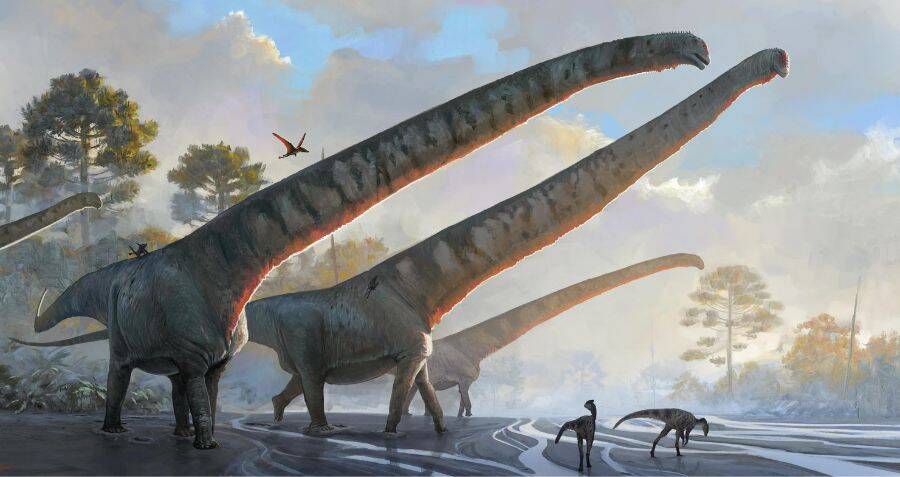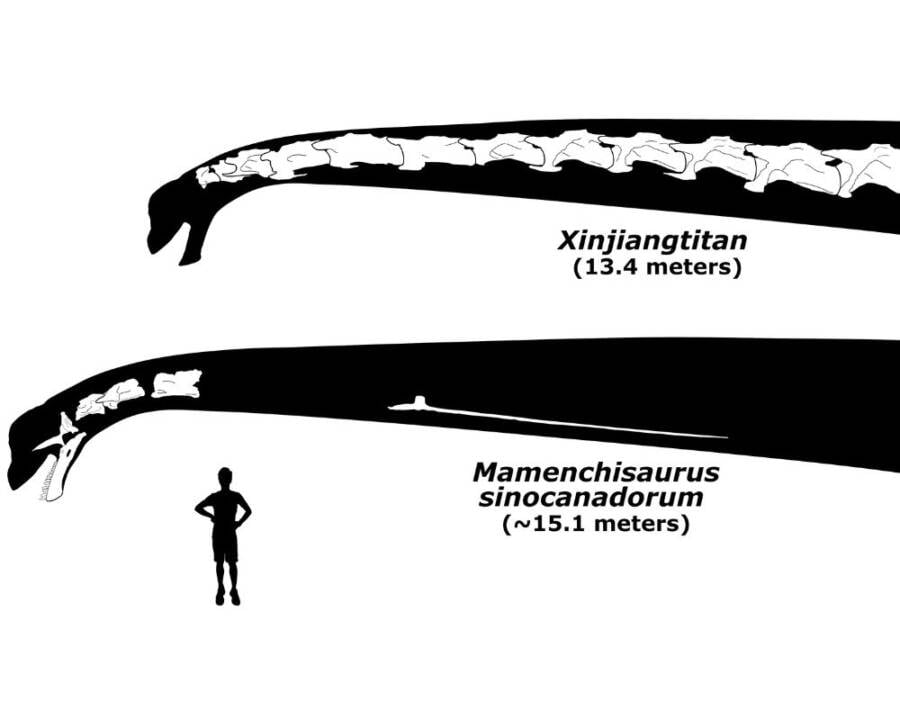
Mamenchisaurus sinocanadorum had a 49.5-foot-long neck that it used to eat vegetation from the tops of the tallest trees 162 million years ago.

Júlia d’OliveiraAn illustration of what Mamenchisaurus sinocanadorum may have looked like.
Archaeologists have just identified the longest neck in the animal kingdom, and it doesn’t belong to a giraffe. Mamenchisaurus sinocanadorum, a species of sauropod, roamed northwestern China 162 million years ago with a nearly 50-foot-long neck.
At 49.5 feet, the towering appendage of Mamenchisaurus was the size of eight giraffe necks stacked one atop another and 10 feet longer than the length of a standard school bus, according to a new study published in the Journal of Systematic Palaeontology.
Researchers previously unearthed the fossilized neck bones of Xinjiangtitan, another species of sauropod that once roamed China. At nearly 44 feet long, the neck of Xinjiangtitan is the longest complete neck in the fossil record. Researchers compared the two related species and found a nearly six-foot difference in their neck lengths.
“By using these more complete, but smaller specimens, we can scale up and make a pretty competent estimate of what Mamenchisaurus would have looked like,” Dr. Andrew Moore, a paleontologist at Stony Brook University in New York, told The New York Times.
When researchers initially discovered Mamenchisaurus in 1987, they found only a jaw bone and a few neck vertebrae.
“What’s particularly tantalizing and frustrating is that oftentimes, the longest necks belong to the things that are the least known in the fossil record for the simple reason that it’s really hard to bury something that large,” Moore continued.
Despite not having the full neck fossil, researchers were still able to conduct tests on the bones to reveal fascinating information about how Mamenchisaurus lived, ate, and breathed with such a long neck.
Scientists were initially puzzled about how the dinosaur sufficiently circulated air throughout its body and kept its neck upright. However, a CT scan found that the dinosaur’s vertebrae were made of nearly 77 percent air. That means that, despite the length of the dinosaur’s neck, it would have been relatively light.
“Having such a long neck is a large weight that you have to position away from your body,” Dr. Cary Woodruff, a paleontologist at the Frost Science Museum in Miami, told The New York Times. “If you have to hold a hammer with your arm stretched out, your arm’s going to get tired pretty quick.”
Additionally, the neck contained “ribs” that protected it from damage. While the ribs may have reduced the dinosaur’s mobility, they kept its body stable. Still, Mamenchisaurus likely kept its head horizontal to the ground most of the time, only lifting it up to forage among the trees.
Perhaps the biggest mystery of all was how the massive dinosaur managed to breathe efficiently.
According to Professor Paul Barrett, Merit Researcher at the Natural History Museum in London, “Like all other sauropod dinosaurs, Mamenchisaurus had a complex breathing apparatus that included not only the lungs, but also numerous balloon-like air sacs. These were connected to the lungs and windpipe but spread throughout the interior of the animal’s neck, chest, and abdomen.”
Barrett continued, “This extra space would have helped these gigantic sauropods to move the large volume of air in the lengthy windpipe that would have occupied their extraordinary necks.”

Andrew MooreA comparison of the neck lengths of Mamenchisaurus sinocanadorum and Xinjiangtitan, its close sauropod relative.
Researchers are still unsure exactly why sauropods evolved to have such a long neck, but “perhaps it made them that much more efficient at foraging,” Moore said.
“The long neck of Mamenchisaurus sinocanadorum, like those of other sauropods, would have made the animal an efficient forager, able to graze on the huge volumes of browse necessary to fuel such a huge body before moving to the next vegetation-rich spot,” Moore told Live Science.
As Mike Taylor, a research associate for the Department of Earth Sciences at the University of Bristol, put it, the discovery is “pretty exciting.”
“We don’t really know what the limits are, because they continue to push them as we make more and more discoveries,” said Moore. “Our default should always be to assume that there’s something larger out there.”